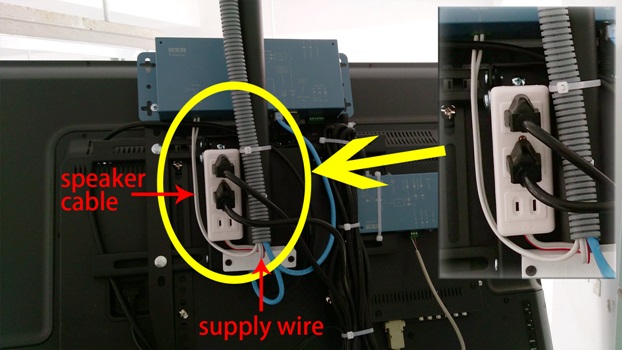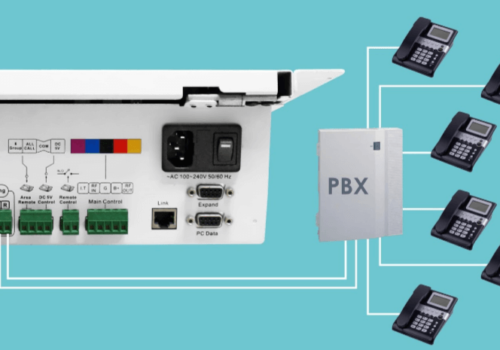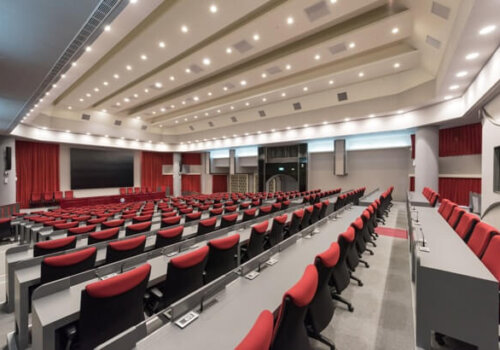Audio-visual engineering is usually considered as “light current engineering”, but do you know what is the difference between light and heavy current?Have you ever thought about what methods could reduce the accidents during construction and even save time of maintenance?
Heavy current vs. light current in electrical engineering

Pic: it’s easy to tell the wiring difference of heavy & light current
Heavy current:
high voltage, high current, high power, but the low frequency. The main issue considered is to decrease power loss and enhance efficiency. Heavy current is generally applied for mains electricity systems and lighting systems such as air-conditioning, sockets, power cabling, and high-voltage wiring.
Light current:
low voltage, low current, low power, but high frequency. The main point to be considered is the quality of signal delivery, including fidelity, speed, breadth, and reliability. Light current is generally divided into two categories: one is the low-voltage electric energy that belongs to national-standard safety grade, including Alternating Current (AC) and Direct Current (DC). 24V DC power and the spare power of emergency light both belong to this category. The other one is loaded with the signal source of sound, image, and data, such as A/V, network, and telephone lines, which is generally within 36V DC. The signal inputs of telephones, computers, televisions (CATV), outputs of acoustic equipment, PA systems, and building auto-control systems (door access and security) all belong to light-current electrical equipment.
Heavy current and light current can be distinguished by:
(1) Difference of frequency
The frequency of heavy current is normally 50Hz, which is also called “utility frequency”. The frequency of light current is much higher, measured with KHz or MHz.
(2) Difference of transmission mode
Heavy current applies power transmission; light current applies wire and wireless transmission.
(3) Difference of power, voltage and current
Heavy current: KW or MW (power); V or KV (voltage); A or KA (current). Light current: W or mW (power); V or mV (voltage); mA or uA (current). It can be constructed by printed circuit or integrated circuit.
Heavy current can also be applied in high-frequency (hundreds of KHz) and intermediate frequency equipment and it’s with higher power and current. Due to the development of techniques, light current has entered into the realm of heavy current, such as power devices and wireless control.
Based on the concept that light current transmits signals and heavy current transmits electric energy, it’s easy to distinguish between heavy and light current. For instance, although the electric razor and flashlight use two batteries (3V), we can’t regard them as light current. It’s electric energy transmission rather than signal transmission. Therefore, they both belong to heavy-current devices.
In summary, high voltage must be heavy current; however, heavy current may not belong to high voltage.
Low voltage must be light current; however, light current may not belong to low voltage.
Low voltage may not be heavy current; heavy current may not be low voltage.
( Reference: https://kknews.cc/zh-tw/home/4qzaeq.html )
In real cases, it generally occurs that the working methods of heavy/light current are against the construction regulations. Some problems can be easily solved, but some can’t. For example, the system’s cabling is messy and the constructor cheats in work or cuts down on materials to lower the cost. Normally, it’s difficult to notice the deficiency from the surface after the construction has been completed. Rather, we should test or actually use the system to find out the problems. If the project engineer could be more careful, it would avoid lots of human mistakes as well as ensure electric safety.
Case study of ICP-5100 Multimedia PA System installed at the high school in Northern Taiwan
ICP-5100 is able to execute daily schedule timer, text announcement, multimedia message display, and general audio broadcasting. It’s also able to remote control the power of A/V equipment (such as TV) of the classrooms via network. There are 7 channels managed by ICP-5131 HDMI Network Signal Converter. One channel is for digital TV, three for DVD (for English listening comprehension exams), and three for live-streaming. The A/V sources can be distributed based on the school’s needs so that BXB’s ICP-5100 was chosen as the best for this project.
There are 19 classrooms and 19 LCD monitors installed in this case. The school requires transmitting A/V signals to the monitors as well as controlling the display equipment. To meet the needs, ICP-5111 IP Decoders and ICP-TV1 TV Control Boxes are installed on the TV hanger. For the construction, the AC 110V power should be arranged. ICP-5111 is included with a Class-D amplifier so that it’s able to be directly connected with the 8Ω speaker. In this case, the power cable and speaker cable are used at the same time, so it’s easy for the engineers and constructors to neglect the cabling regulations as below:
1. Cables for heavy current and light current are not distinguished (use the same type of wires rather than distinguishing the cables by colors).
2. The wires for heavy current and light current aren’t separated (not branched out) but share the same wire tube.
3. The both ends of wires for heavy current and light current are not clearly marked, which is hard to be recognized.

Pic: the speaker cable and power supply wire is the same, which causes serious problems
The above mistakes have been made in the 19 classrooms. The IC chips inside the two decoders are burned and broken because the AC 110V supply wire was misconnected to the speaker output connector of the decoders.
To avoid the mistakes, we make the suggestions below:
1. Use different colors of cables : to distinguish the speaker cable and supply wire.
2. Mark on the wires : fix the label or cable tie at both sides of the wires for easy recognition.
3. Divide the circuits : make the circuit of heavy current and light current work individually instead of sharing the same wire tube.

In conclusion, we hope this article helps all engineers with construction quality and safety. After all, electric power utilization is the matter we generally experience in construction environments. Therefore, it should not be negligent but be deeply understood. It’s better to be safe than sorry.
#ElectricalEngineering #ElectricalEngineer #LightCurrentSystem #LightCurrentEngineering #audio-visual




